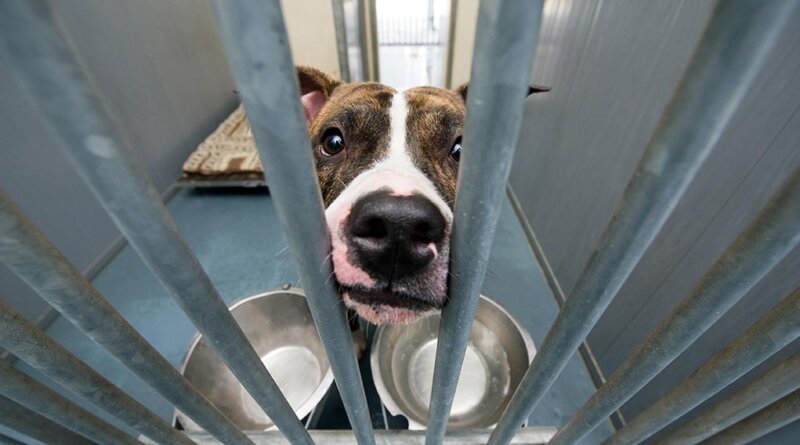What To Look For In The Dog & The Shelter – Top Dog Tips
With many shelters consistently at maximum capacity, it’s always a great idea to adopt a dog whenever possible. For some pet owners, the thought of choosing a shelter dog is overwhelming.
After all, the dogs currently available for adoption have been surrendered without extensive histories or knowledge about any behavior or health concerns.
To help you choose the best match for your household, here are a few things you need to consider before taking the plunge into adopting a dog.
Adopting a Shelter Dog: What You Need to Know Before
Many people believe adopting a dog is as simple as finding the closest rescue, looking online, and bringing their new furry companion home.
While this may occasionally work, you may be setting yourself up for disaster without the proper time, energy, and considerations.
You’ll want to consider a few things before finding your next companion.
Consider where your dog will be spending most of his time
Shelters are considered highly stressful environments for dogs, mainly as there is often a change in environment and a mental and emotional detachment from their previous owners.
Some dogs may forget basic housebreaking, resorting to relieving themselves as needed, instead of outdoors as you’d expect. Plan for a few accidents around the home after bringing home the new family member.
Ensure that you have plenty of cleaning supplies on hand (including a carpet cleaner, if needed) to take care of any accidents
Set Your Dog Up for Expectations
If you’re planning on crate training your dog, make sure to have it set up and in place before they arrive home.
You’ll want to ensure that the dog crate is large enough that the dog can stand up, turn around, and lay down comfortably without too much space. You’ll want to keep the crate clear of any items like blankets, pillows, or plush toys.
These can become choking hazards if the dog is left unattended and decides to chew or mouth them.
Get Down on His Level
Like toddlers, dogs are known for exploring their homes quickly and thoroughly. Before bringing your new furry friend home, please take a quick look through the house at his level.
You’ll want to pick up any shoes, expensive items, or clothing off the ground – especially if the dog you’ve chosen is a chewer or enjoys relieving himself on various things.
It’s also essential to secure any loose wiring, cords, or electrical items like lamps whenever possible.
Should you be an avid plant collector, take a few moments to research toxicity with animals. Some plants can be lethal or cause kidney failure in pups, which can be dangerous for curious dogs trying to learn their surroundings.
Finally, you’ll want to put any breakable or hazardous chemicals up on high shelves to avoid injury or ailment.
Always Be Honest and Transparent with Shelter Staff
It may seem like a no-brainer, but many shelters have questionnaires and surveys to complete before adopting a dog.
Questions like household environment, yard space, children, and pets can influence the compatibility of a rescue – so make sure you’re honest every step of the way.
A dog that lived with a quiet senior in a detached home may not adapt well to a busy family with young children.
Always Take Size and Breed into Account
Although you may love the look of a terrier rescue, if the pup is a high-energy breed, you need to be prepared for the activity that brings.
Likewise, large breed dogs may not do well in a small apartment. Although many dogs within a shelter are mixed breeds, make sure to talk to the dog shelter about any prominent traits the dog has.
If you know that you do not want to run the dog daily, opt for a lower energy pup. Remember, children (even teenagers) are not reliable caretakers for a dog.
Commitment to the puppy will ultimately fall on you, so make sure you’re comfortable with the personality and energy of the dog before committing to him.
Understand it Takes Time to Adapt
Think back to the last time that you moved homes or locations for work. It’s a stressful and uncertain time—which is no different than dogs.
Your dog may take several weeks to relax and become used to its surroundings, especially if there are children or other pets in the home.
Always talk to the shelter about any supplements you can use to lower anxiety throughout the day, especially if you find the dog is skittish or uneasy.
Make sure to remind children to give the dog space for the first few days especially. When under stress, some dogs may feel defensive and can become nippy.
What to Look for In a Shelter Dog
Every dog in the shelter will have a unique personality, but that may not shine through in a high-stress environment. To find your perfect match, consider following these tips to choosing an excellent pup for your family.
Observe the Dog from a Distance and Up Close
Body language is a significant determining factor for a dog’s temperament, so pay careful attention to what they’re trying to show you.
A dog that lays curled up scared in the corner of his kennel may not be adapting to the situation he’s in, but he may also not be overly friendly either.
Pay attention to what the dog does when people or other dogs walk by. Do loud noises make him seem jumpy and timid? Does he bark, whine, or growl?
The floor (where all dog kennels are kept together) is a very stressful place for any dog, so paying attention to his body language in that environment is essential.
Please pay attention to how he walks on a leash.
Whenever possible, ask a volunteer or employee to remove the dog from his kennel and walk through a common area.
Observe how the dog responds to the leash, environment, and stimulation. Is he confident and forward? Does he cower and have his tail between his legs?
Does the dog lunge or raise his fur on his neck and back? Ideally, the dog should be confident with a wagging tail and relaxed position.
Take the Dog to a Private Room
Remove as much stimulation as possible and spend a few moments with the dog privately.
Without trying to engage, watch for the dog’s body language as it explores the room. A curious and confident dog will try exploring the space with its tail up and wagging.
A shy dog may try to escape through the closed door or will cower in the corner.
Try not to deliberately startle the dog (as you don’t want to create a negative attachment to you) but if there are loud or distracting sounds, monitor its reaction.
See How the Dog Interacts with You
With constant stimulation inside the kennel, many dogs may not interact well with potential owners in the shelter.
Don’t be alarmed if he doesn’t seem to engage with you, but try getting his attention through his name, whistling, making kissing noises, or similar interactions.
A well-adapted dog will approach you (even if timidly). Monitor any interactions with him you may have. A confident dog will come to you when called and may seem excited to engage.
You can also see if the dog knows any training by asking basic commands from him, like ‘sit,’ ‘down,’ or ‘stay.’
Talk to the shelter volunteers about any known behavioral issues like biting, nipping, food guarding, or pulling on a leash.
Although protecting food in a shelter may be related to the environment having prior knowledge can make the difference at home.
Return with Other Pets
Many shelters will require a follow-up visit with any household family members (including spouses, children, and animals) to ensure a smooth transition.
After all, if the dogs won’t get along, it will not be a positive adoption experience for anyone. Ask the volunteers or staff to arrange a follow-up visit with any other dogs in the household for a meet and greet.
What to Look for In a Dog Shelter
When it comes to pet adoption, not all rescues or shelters are created equally. Many rescue organizations cater to specific breeds, whereas other shelters will take all dogs and adopt them out as quickly as possible.
If you know you want a particular dog breed, contact local rescue organizations. Should the breed not matter to you, local non-profit shelters are a great way to add a new family member.
Before committing to a new dog, here are a few things to look for in a dog shelter.
Look for No-Kill Animal Shelters
A no-kill animal shelter is pretty self-explanatory, but unfortunately, quite rare. With countless dogs being surrendered, there is only so much space for potential pups to stay housed.
Always ask the shelter in question about their status on euthanasia. Some may have a time limit on adoption, while others may take temperament into account before making any decisions.
No-kill shelters will not euthanize an animal due to time restraints but may find other foster homes to house their animals.
Look at the shelter’s cleanliness.
Although it seems trivial, always take a good look around the shelter before rescuing a dog. Accidents and messes may happen, but a good shelter will have a clean and sanitized environment for their dogs.
Check for excrement or urine in the kennel and look at any food bowls in the space. If the kennels or dishes are dirty, there’s a good chance that the dogs may not be in optimal health.
A reputable shelter will be clean, bright, and inviting to potential owners.
Ask About Their Adoption Policies
Inquire about any adoption policies, timelines, or fees associated with the shelter. Many shelters will have fees or donations to secure a new furry friend; you’ll also want to find a shelter that cares about the compatibility of their animals and potential homes.
Any shelter that is willing to adopt a dog without screening potential owners is probably trying to move high quantities of dogs.
This pattern of dog adoption suggests there’s a higher chance of your dog being a mismatch to your home life, which can be devastating for both dog and family.
Confirm any records before adoption
Always ask to see any vet records, surrender information relating to the dog, and any ongoing reports from the shelter.
A dog rescue should always have their animals seen by a vet upon surrender to ensure the dog is in good overall health. You’ll also want to see proof of vaccination and any treatment like heartworm medications.
While some shelters may not have this information available to the public, they should be willing to give the records to the new owners.
If it’s been a while since the dog has seen a vet, inquire about any health guarantees after adoption.
Ask for referrals from friends and family.
Adopting a dog is a very private and personal decision, but asking for a reputable shelter can save you time and energy down the road.
Social media is another excellent way to get in touch with high-quality dog shelters, especially if they’re active on platforms. Look into different reviews online and see what others have to say about the organization.
Some individuals may leave negative reviews for virtually any reason and establish overall patterns with their clients.
When you find a shelter with multiple negative reviews and similar accusations, avoid them at all costs.
Final Thoughts When Adopting A Shelter Dog
Adopting a shelter dog should be a fun and exciting time for you and your family. By taking the time to ensure these tips and suggestions are followed, you’ll be more likely to find yourself a new happy, and loving family member.
Remember, it’s always better to remain cautious when choosing a pet than to return an unsuitable dog.
READ NEXT: Returning Dog to Shelter? Consider This First












